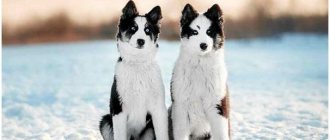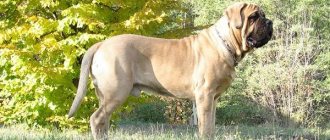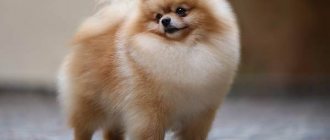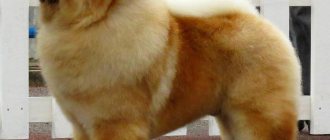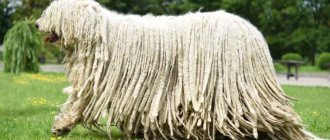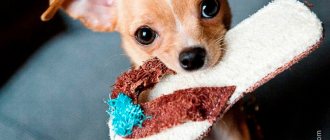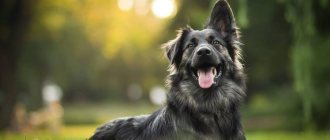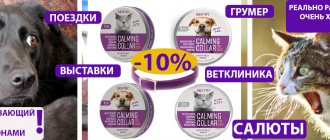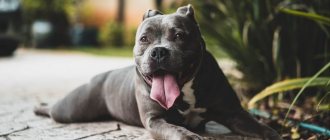Home » Interesting collections about cats and dogs
German dog breeds are perhaps the most popular. This is not surprising: among their common traits, the owners highlight an obedient and disciplined disposition, high intelligence, dignity and stature. In addition, the Germans worked on the service qualities of dogs. There are guards, hunters, and search pets... If you want to buy a dog of the German breed, check out the list: there will probably be one you like.
- 2 German boxer
- 3 German Jagdterrier
- 4 Drathaar
- 5 Kurzhaar
- 6 Great Dane
- 7 German Spitz
- 8 Rottweiler
- 9 Doberman
- 10 Leonberger
- 11 Weimaraner
- 12 Miniature Schnauzer
- 13 Miniature Pinscher
- 14 Reviews from dog owners
German Shepherd
This is a calm and loyal dog that was bred for search work and protection. Thanks to their classic physique, shepherds do not have any specific health problems. The disadvantages of the breed include the need for mental and physical stress.
The dog has short but thick hair, color - sable, zone, black, white
Breed standard (appearance)
The proportions of the dog were created based on practical conditions, therefore the description of the breed and the characteristics of the Jagdterrier are simple appearance and exterior:
- The skull is moderately elongated, wedge-shaped, flat. The muzzle is harmoniously formed, shorter than the head.
- The neck is of medium length, with good muscle tone.
- The body is slightly elongated with a straight top of the body and a strong loin, the length of the body is not much greater than the height at the withers, the belly has a refined curve.
- The chest is deep, the girth should not exceed the height at the withers by 12 cm, the ribs are arched and laid back.
- Teeth – 42 pcs., large, smooth, brightly pigmented. Strong jaws with a tenacious grip and scissor bite are clearly defined.
- The eyes are brown, small, deep-set, spaced far apart, with a straight gaze.
- The ears are triangular in shape, hanging, set high, small in size, not very pointed.
- The front legs are parallel, round in shape with rough, dense pads, have strong bones, dried muscles, elongated slanting shoulder blades, steep forearms and elbows without eversion.
- Hind feet with strong knees, shins, thighs and hard pads on the toes.
- Wool – The covering hair has a coarse, dense texture.
- The tail is straight, curved, like a saber, docked by one third.
Important! The tip of the tail should not deviate towards the back. During a burrow hunt, the owner should be able to pull the angry dog out of the ground precisely by this part. But this parameter does not affect the cost of puppies, since in some countries the docking procedure is completely prohibited.
Popular colors of German Jagd Terriers
Color of the Jagdterrier
There are two variants of the coat: smooth-haired Jagdterrier and wire-haired. The first one has an even covering hair. The Wirehaired Jagd Terrier is distinguished by disheveled guard hair on the chest and a protruding beard, similar to that of the Fox Terrier. The most common color is black and tan. The nose is usually black, but a coffee tint is acceptable for individuals with the same coat color. Also found:
- brown with slightly lighter ends;
- tan and gray;
- black with red and gray;
- completely dark brown;
- smooth-haired completely black.
In both long-haired and smooth-haired coats, dark gold or red tan markings are allowed. They have clear boundaries and are located at the base of the tail, on the eyebrows, the front of the head, the chest, and the ends of the legs. The color is complemented by a dark or whitish mask and white spots in the toes and chest.
German boxer
The Boxer is a balanced dog who is often assigned the role of nanny. However, it is important to understand that it is better not to leave any pet unattended with a child. Boxers are distinguished by loyalty and a high level of intelligence, but due to their short hair they often get cold. In addition, the flattened muzzle can cause problems with the eyes and heart.
Boxers are relatively small: their average weight is 20 kg
Leonberger
- Height – up to 80 cm
- Weight – up to 75 kg
A large breed of dog, it has much in common with the appearance of a lion. Despite its size, the dog is distinguished by its poise, restraint, fearlessness and devotion. The Leonberger's coat is thick, brown, fawn or dark in color. Can be used as a guide, watchman and security guard; he loves children very much.
Pros:
- obedient;
- treats other animals well;
- easy to learn.
Minuses:
- requires special coat care;
- need to be walked frequently.
It is important to understand that most German dog breeds are large animals that are best kept outside the city or in a private home. But peacefulness and restraint are inherent in every pet.
https://youtu.be/moIR4OPgFDo
German Jagdterrier
The Jagdterrier is an unpretentious hunting dog. He copes with the role of a companion with difficulty, but is well suited for those people who do not like intrusive animals. The Jagdterrier is independent and independent. However, these dogs can be aggressive, so they need regular training and discipline.
The dog is easy to care for and easily takes root in any conditions.
Brief history of origin
The hunting terrier was first bred at the beginning of the 19th century by German breeders, but not everything went smoothly: ancient beliefs and prejudices of experienced hunters did not accept the multi-colored breed, because it would not bring good luck during the hunt.
The basis for breeding a new hunter were: German toy terrier, pinscher, several varieties of dachshund and fox terrier, while strict appearance was not considered a priority.
On a note. The German breeder Walter Zanzenberg believed that appearance was a secondary issue when breeding a new breed of burrow hunter, so he took fox terrier puppies as a basis, which became the progenitors of the new breed of German Jagdterrier.
The main task of the small dog was to track the animal: to find its shelter and drive the animal out of the hole or strangle it and carry it to its owner. The possibility of following hares along the trail was also taken into account. Given its small size and special rage during the rut of the beast, the Yah Terrier became an excellent tracker.
Already in the 30s of the last century, German dog handlers managed to establish the first standards for a small hunting dog, which are used all over the world today.
Many users incorrectly call this unique breed of fearless hunter: Yak Terrier, Yah Terrier or Young Terrier, but there is only one correct name - Jagdterrier or German Hunting Terrier.
Kurzhaar
The Shorthaired Pointer is another breed that is good at guarding and hunting. The advantages of these dogs include their reserved character and loyalty to their owner. The shorthaired pointer is easy to train. It does not require careful care. However, representatives of this breed are absolutely not suitable for apartment living.
The body is athletic and slender, the color is dark, sometimes with a milky tint and inclusions
Rottweiler
- Height – up to 60 cm
- Weight – up to 50 kg
It was bred in Germany and is distinguished by its stable character, endurance, intelligence and restraint. Previously used for grazing livestock, later as a watchman or security guard. The coat is smooth, shiny, color is black with tan marks of red and brown. By nature, smooth-haired Rottweilers are loyal and peaceful dogs, and are wary of strangers.
Pros:
- love children;
- not aggressive.
Minuses:
- requires constant walking and training;
- do not cope well with family changes.
German dog
The Great Dane is a record holder among dogs. The height of the pets reaches 110 cm at the withers, the average is 80–90 cm. These are very friendly dogs, but they are playful, and therefore can accidentally injure a person. It is better to keep them outside the city to ensure an optimal level of exercise.
It has a large size, color - fawn, merle, gray, black and blue
Dachshund
- Height to shoulders: from 12.7 to 15.3 cm (miniature), from 20.3 to 23 cm (standard)
- Weight: up to 5 kg (miniature), from 7.3 to 14.5 kg (standard)
- Life expectancy: 12 to 16 years
- Average cost: from 300 to 1000 dollars
More than 300 years ago, the dachshund was bred to hunt badgers. The German word for dachshund is “dachshund” (“dach” means “badger” and “hund” means “dog”). These dogs used their narrow, long noses to explore dens, and their sharp claws and powerful short legs helped them quickly dig through the ground.
Dachshunds come in two sizes: miniature and standard. Both are ideal for those looking for an apartment dog for small spaces.
Dachshunds are persistent and very intelligent pets; They never give up , whether they're waiting for a squirrel under the deck or stretching as far as they can to get a toy bunny from under the sofa. Be prepared for them to bark until they catch their discovered “prey.”
German Spitz
The Spitz is a small decorative dog that can charm anyone. However, it should be remembered that the fur of these pets must be carefully looked after. In addition, they are prone to obesity. But they are peaceful companions who love to spend time next to their owners.
The coat is thick and fluffy, color - white, gray, there is an undercoat
How to choose the right puppy?
Before choosing, you should carefully study the pedigree to find out what achievements the parents have.
The fact is that, together with the mother’s milk, the Jagd Terrier puppy absorbs all the best that the breed has, and the hunting instinct and special skills are transmitted at the genetic level.
If Jagdterrier puppies have lived next to a nursing mother for three months, then they are already thoroughly prepared for adult life. At this age, the dog can feed itself and is ready to move to a new family.
When choosing a little hunter, be sure to check what vaccinations he has already received and inspect the coat for light spots, which are unacceptable in this breed.
On a note. You should take a closer look at the behavior of your pet during a quarrel with his brothers - if he defends his rights to the end, then he will also aggressively drive the animal.
But if a dog is needed only for hunting, and not for participation in exhibitions, then the pedigree does not matter much and it is not worth overpaying for purebredness.
Miniature Schnauzer
The Schnauzer is considered one of the smallest working dogs: they weigh only 6–8 kg. Despite their size, dwarf schnauzers are very brave and loyal. They are active, so you need to deal with them, otherwise destruction in the house cannot be avoided.
The color can be silver, black, white, the coat is short, but thick and soft
Weimaraner
- Height to shoulders: from 58.4 to 68.6 cm
- Weight: from 25 to 40.8 kg
- Life expectancy: 10 to 13 years
- Average cost: from 700 to 1500 dollars
The Weimaraner, known as the "gray ghost" mainly due to its coloring, stealth hunting skills and speed, is not a couch potato. Well, at least until all of his physical exercises are completed for the day.
These are very active dogs, great for running and walking . They are so focused on human interaction that “me time” is a foreign concept to them. Several famous people, including Grace Kelly and President Dwight D. Eisenhower, helped popularize the Weimar Cop.
miniature pinscher
With proper training, the Pinscher will become a loyal, friendly and independent pet. However, under unfavorable circumstances, these dogs manipulate their owners and create chaos in the house, so they are not suitable for soft-tempered owners.
Gets along well with older children, but is not suitable company for an unintelligent child, as he can respond to careless actions towards himself with aggression
Nutrition
your German Jagdterrier dog dry food. To do this, you need to choose it correctly so that it has the correct balance of all vitamins and minerals.
The German Jagd Terrier is an excellent swimmer for game.
Dogs can also be fed natural products. But, here you will have to be a little puzzled, and create your pet’s menu correctly, taking into account all the features. An adult male needs to be fed 2 times a day, and a female – 3 times.
Allowed:
- meat. It should be in your dog's diet every day. Chicken, beef and lean lamb are the best for this pet;
- meat by-products – heart, kidneys, lungs, chicken gizzards;
- rice, buckwheat, millet cooked in water;
- boiled potatoes, raw carrots, beets, zucchini and cabbage;
- low-fat cottage cheese, milk, fermented baked milk and kefir. Sometimes, you can pamper him with curdled milk;
- add greens, sorrel, and young nettles to food.
Seasonally, it is necessary to give a complex of vitamins, after consultation with a veterinarian. Prohibited: sausages, raw and river fish, white bread, spices and seasonings, legumes and pasta, baked goods and sweets, smoked and pickled foods, fatty and fried foods.
Doberman
The breed was named after its creator, Karl Friedrich Louis Dobermann. He lived by collecting taxes and rent payments, so there was often a risk of being robbed. Being a passionate dog lover, he decided to breed a breed that was distinguished by courage, kindness, courage and obedience.
Dobermans are in the “golden mean”, combining moderate anger, excitability, temperament and psyche. Outwardly they are very aggressive, so few people would dare to tease such a dog. They are easy to train, become very attached to their owners, and get along well with pets.
The height of males reaches 67-73 cm, weight 41-46 kg, for females it is typical to reach 62-69 cm in height and weigh 33-36 kg. The Doberman has short, smooth fur, most often black or brown in color. The tail is docked in most cases.
All about the German Doberman dog breed in a full review.
Vaccinations and susceptibility to disease
German Jagd Terriers are distinguished by excellent health and do not have hereditary diseases. The first vaccination is given to puppies at the age of 2.5 to 3 months, then 21 days later - repeated vaccination.
At six months they are required to be vaccinated against rabies and given a complex vaccine against several standard diseases.
Important! Vaccination should not be carried out during the period of teeth change in puppies.
When the dog turns 12 months old, repeated comprehensive vaccination is necessary. Subsequently, it is carried out annually.
If the dog is used for hunting and is constantly in contact with wild animals, then anthelmintic prophylaxis is given every three months.
Jagdterriers practically do not get sick, but they can get injured during a hunt or catch a cold during the cold season. If your hunting dog sleeps a lot or has no appetite, you should immediately contact a veterinarian.
